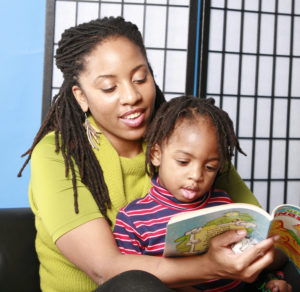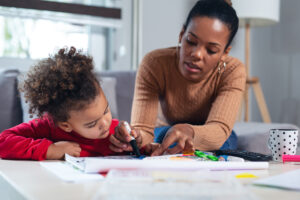20 Shared Reading Tips to Share with Parents
March 26, 2019
*This popular post was updated in 2021 with more great tips from the experts. Have a tip of your own to share? Add it in the comments below!
Shared storybook reading is one of the greatest gifts a parent can give a child. At its best, this one activity can promote strong parent-child attachment, nurture key early language and literacy skills, strengthen a child’s pride in their cultural and personal identity, expand their knowledge of the world, and help them process strong emotions and deal with life’s challenges.
Today’s post gives you 20 practical shared reading tips, adapted from some new and classic Brookes books from top early childhood experts. Share this post with families, and help them make the most of their special storytimes with young children.
 Select high-quality books that interest your child. You might want to ask a children’s librarian or child care providers or teachers for guidance and book recommendations. Be sure not to underestimate the level of language or information your child may enjoy. Sometimes grownups limit their selections to books with simple words intended for beginning readers, but it’s also important to choose books that stretch your child’s spoken language and expand their knowledge.
Select high-quality books that interest your child. You might want to ask a children’s librarian or child care providers or teachers for guidance and book recommendations. Be sure not to underestimate the level of language or information your child may enjoy. Sometimes grownups limit their selections to books with simple words intended for beginning readers, but it’s also important to choose books that stretch your child’s spoken language and expand their knowledge.
Ensure that children “see themselves” in books you read. Cultivate a diverse library, including books that feature characters who look like your child and share their cultural background, family structure, and interests. For children of color and those with disabilities or challenges, who may often be exposed to stereotyped images in mainstream culture, books that provide realistic images and affirmation of identity are essential (even for very young children).
 Stock your library with different kinds of books. Storybooks are important, but don’t forget to include informational books that teach young children about key concepts and expand their knowledge of the world (e.g., books about animals, machines, natural phenomena, and other countries).
Stock your library with different kinds of books. Storybooks are important, but don’t forget to include informational books that teach young children about key concepts and expand their knowledge of the world (e.g., books about animals, machines, natural phenomena, and other countries).
Set the stage for success with comfortable seating, a quiet environment free from distractions, and sufficient lighting for reading the print and examining the pictures. (It might be helpful to have a designated reading space prepared so you can share a book whenever the opportunity arises.) Position yourselves so that you and the child (or children) can see the book at the same time.
Engage your child with questions about the book. Ask questions that challenge and “stretch” your child. These may be questions about the names for things, but they can also be about why characters are doing things or how they’re feeling. Informational books can give you rich starting points for talk about the physical world. Praise your child when they respond to your questions and ask their own!
 Build your child’s world knowledge. Be alert for instances when the time period or location of the story’s events are unfamiliar to your child. Make sure you give the child enough information to understand the story. When you’re reading informational books, be especially aware of the need to ask questions and respond to your child’s questions. These mini-lessons should be brief and can occur at any time as you read.
Build your child’s world knowledge. Be alert for instances when the time period or location of the story’s events are unfamiliar to your child. Make sure you give the child enough information to understand the story. When you’re reading informational books, be especially aware of the need to ask questions and respond to your child’s questions. These mini-lessons should be brief and can occur at any time as you read.
Use books to expand your child’s vocabulary. Watch for words you think your child may not know and briefly talk about them. When you reread a book, ask your child if he remembers what the word means, and try to use new words at other times of the day to reinforce knowledge.
 Encourage letter learning as you read. Try pointing to letters as you say their names, singing a slowed-down ABC song while you point to each letter in the book. Turn to random pages in the book and see if children can name and point to the letters themselves. You can follow up by having your child make their own ABC book by finding or drawing pictures for each letter.
Encourage letter learning as you read. Try pointing to letters as you say their names, singing a slowed-down ABC song while you point to each letter in the book. Turn to random pages in the book and see if children can name and point to the letters themselves. You can follow up by having your child make their own ABC book by finding or drawing pictures for each letter.
Read a story with a strong pattern. Encourage the child to retell the story, replicating the pattern. After your child has learned to retell the story, have him create his own story with similar patterns.
 Differentiate print from pictures. There are two ways to do this. The first way is to track the print in the storybook by running a finger under the line of print in a smooth motion from left to right. This nonverbal cue shows children what is being read and may help them associate the printed word with the spoken word. A second way to show the difference is by pointing to an illustration and saying, “Here is a picture that shows what is happening in the story,” and then pointing to the print and saying, “These are the words that tell the story.” Doing this two or three times during one or two reading sessions may be all that is necessary for children to acquire this skill.
Differentiate print from pictures. There are two ways to do this. The first way is to track the print in the storybook by running a finger under the line of print in a smooth motion from left to right. This nonverbal cue shows children what is being read and may help them associate the printed word with the spoken word. A second way to show the difference is by pointing to an illustration and saying, “Here is a picture that shows what is happening in the story,” and then pointing to the print and saying, “These are the words that tell the story.” Doing this two or three times during one or two reading sessions may be all that is necessary for children to acquire this skill.
Play a rhyming game. Select a storybook that contains one word that rhymes with at least two other words by changing the initial sound (e.g., tea/sea/key, tell/bell/fell). During shared reading, interrupt the story when the target word appears and make a comment: “This word tea sounds like the word sea. The words tea and sea rhyme, which means that they sound the same except for the first sound. Tea starts with a ‘tuh’ sound, and sea starts with a ’sss’ sound. Can you think of another word that rhymes with tea and sea?”
 Strengthen your child’s comprehension skills by helping her understand the book while remaining alert for questions or signs of confusion. Notice things that might be confusing, and ask your child questions (“Why do you think he wanted to do that?”). Make connections to your child’s life and experiences, and give her information beyond what’s provided in the book.
Strengthen your child’s comprehension skills by helping her understand the book while remaining alert for questions or signs of confusion. Notice things that might be confusing, and ask your child questions (“Why do you think he wanted to do that?”). Make connections to your child’s life and experiences, and give her information beyond what’s provided in the book.
Adapt books if necessary. For young children with disabilities, modifications may be needed to provide opportunities for developing preliteracy skills. Try attaching foam pieces to the edges of the pages to make page-turning easier, simplifying books by stressing key words or shortening sentences, using photographs and other materials that extend the concepts and vocabulary, and adding tactile experiences while reading to children with vision and hearing loss.
Use books as “bibliotherapy.” Choose books that deal with tough emotions and tell reassuring stories about characters who struggle with sibling rivalry; conflicts with friends; feelings of smallness, guilt, or inadequacy; or feelings of being left out or different. These can help children work out common fears, worries, and social problems.
 Make reading an enjoyable routine. As you read the book, laugh a lot. Respond to your child’s interests and comments, and share your own enthusiasm, questions, and enjoyment. Try to make it a regular routine—read at the same time each day if you can.
Make reading an enjoyable routine. As you read the book, laugh a lot. Respond to your child’s interests and comments, and share your own enthusiasm, questions, and enjoyment. Try to make it a regular routine—read at the same time each day if you can.
Reread books. It’s no secret that children enjoy hearing their favorite books many times! That’s a good thing: repetition gives them many chances to absorb the language of the book. Make sure you select high-quality books to increase the usefulness of these repeat readings.
Add signs as you read. Some children benefit from “doing a book” instead of just listening and looking as the book is being read to them. Add some key signed words to your shared book reading that children can easily imitate. They will especially delight in signed and spoken phrases when the book includes rhythm, rhyme, and repetition. (The new book Sing & Sign for Young Children by Anne Meeker Watson is all about combining singing, signing, and reading to enhance early literacy skills and more!)
 Engage them with expressiveness. Keep in mind that how you read is as important as what you read. To keep young children engaged as you share a story together, be sure to use your most interesting facial expressions and entertaining vocal inflections.
Engage them with expressiveness. Keep in mind that how you read is as important as what you read. To keep young children engaged as you share a story together, be sure to use your most interesting facial expressions and entertaining vocal inflections.
Try singing a book. Select a picture book with rhythm, rhyme, and repetition, and either borrow a melody or make up your own. Author Anne Meeker Watson provides an example: one of her favorite picture books to sing is Time for Bed by Mem Fox. She borrows the melody from “Twinkle, Twinkle, Little Star” to sing lines from the book like “It’s time for bed, little goose, little goose, the stars are out and on the loose.” Singing a book can also support emotional regulation by helping children feel calm and present in the moment.
 Encourage children to create their own books. To reinforce a child’s emerging love of reading, help them write their own books. It’s a wonderful way to preserve precious memories of special or exciting events, and it will build their literacy skills at the same time. Write the child’s words down and read them back out loud, pointing to each word as you read it. (This will help children understand that the actual words they say are being put on a page.) Encourage the child to create artwork to illustrate the book.
Encourage children to create their own books. To reinforce a child’s emerging love of reading, help them write their own books. It’s a wonderful way to preserve precious memories of special or exciting events, and it will build their literacy skills at the same time. Write the child’s words down and read them back out loud, pointing to each word as you read it. (This will help children understand that the actual words they say are being put on a page.) Encourage the child to create artwork to illustrate the book.
Like today’s blog post? Check out the books that inspired it:
Tips 1, 3, 5, 6, 7, 9, 12, 15, and 16 adapted from Connecting Through Talk by David K. Dickinson & Ann B. Morse
Tips 2, 8, 9, and 14 adapted from Talk to Me, Baby! by Betty Bardige
Tip 13 adapted from Assistive Technology for Young Children by Kathleen Curry Sadao and Nancy B. Robinson
Tips 4, 10, and 11 adapted from Shared Storybook Reading by Helen Ezell & Laura Justice
Tips 17-19 adapted from Sing & Sign for Young Children by Anne Meeker Watson
Tip 20 adapted from User’s Guide to the Child/Home Early Language and Literacy Observation (CHELLO) by Susan B. Neuman, Julie Dwyer, & Serene Koh




Write a Comment
Your email address will not be published. Required fields are marked *
Post a Comment